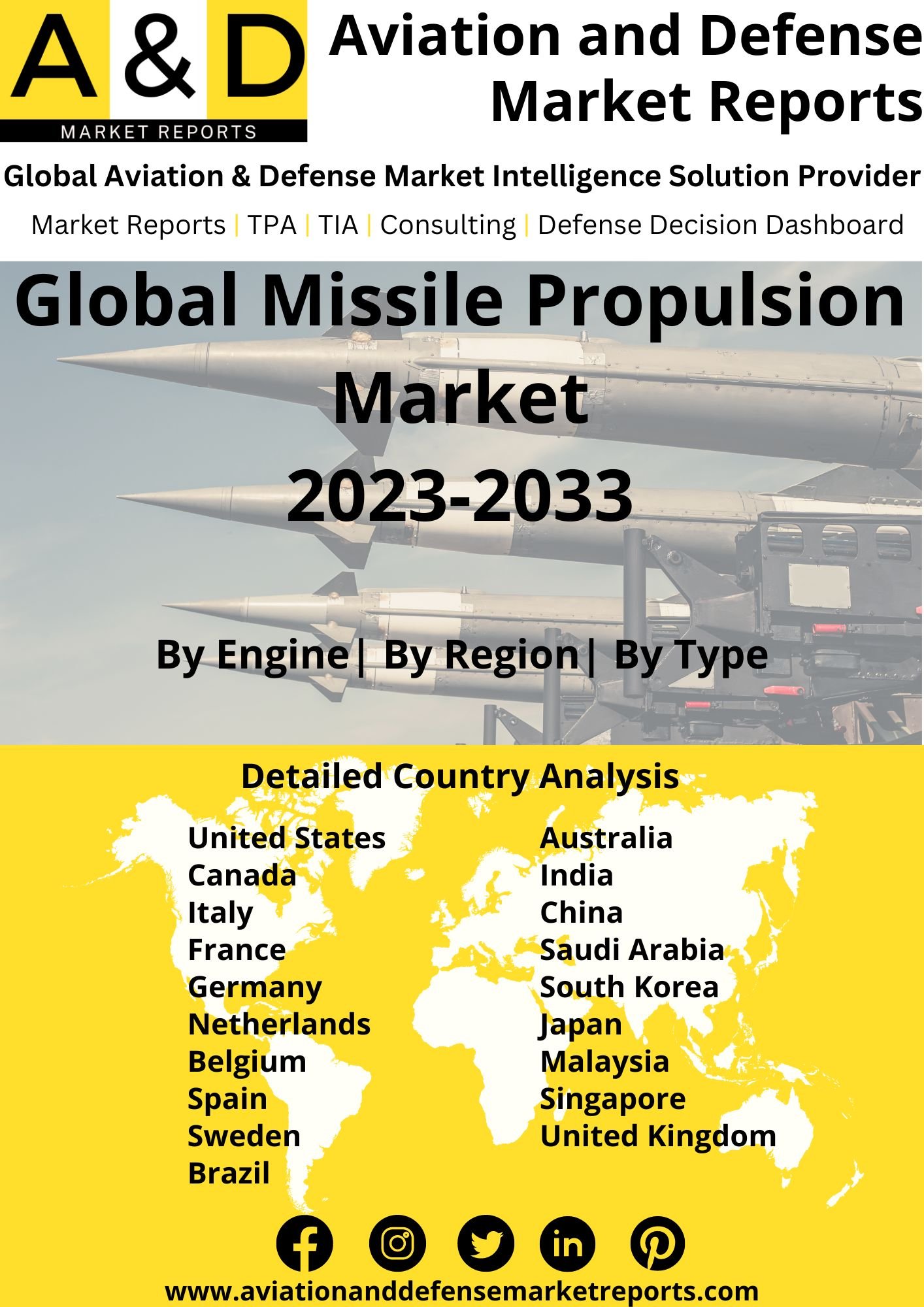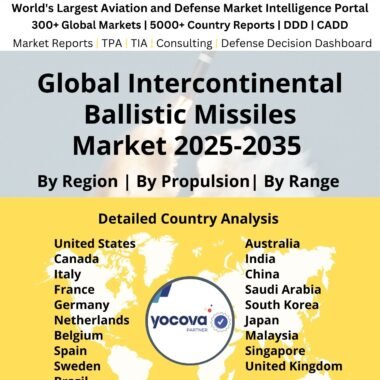Description
Missile Propulsion Market
Frequently Asked Questions of Missile Propulsion Market
There have been restrictions to anti-air missiles. Most importantly, there has always been a yearning for greater variety. The explanation is simple and holds true even today: only one-fifth of a rocket motor’s weight is fuel, which means that burn time and range are relatively short. What we have here is a traditional rocket motor with a motor case, a blast pipe, and a nozzle, and inside there is a propellant that consists of 80% oxygen, but only 20% can be used for the real propellant that is burning, which limits range velocity and height coverage.
New rocket motor design, the ramjet motor differs in that it does not require oxidizer to be carried; instead, at very high speeds, atmospheric air enters an air intake, is compressed, and as temperature rises, it is ignited together with the rocket fuel; when the oxidizer is removed, 80% of the weight can be removed, and there is room for up to five times more fuel because the missile is flying in the atmosphere, has an air intake here, which means it is possible to remove all of the oxygen in the propellant and use the air intake as a compressor. When it gets up to Mach 3 or so, the air intake acts as a compressor, allowing you to get much longer ranges and maintain velocity for all of the burn times, possibly up to 3 400 seconds at Mach 3 and this is, of course, a huge leap forward from the old type of technology. The ramjet could be applied to virtually any missile here to air missiles could see ranges up to 500 kilometers naval missiles could go several times further out than missiles powered by turbo fan and turbojet engines.
Major factors driving Missile Propulsion Market Growth
Some of the major factors driving the growth of the missile propulsion market are proliferation of cruise missiles, ATGMs and other shoulder fired missiles. 3D printing also known as additive manufacturing is also a key missile propulsion market trend that enable the growth of the market. 3D printing enables manufacturers to keep costs under control and iterate on designs rapidly.
Trends influencing the Missile-Propulsion Market Size
Advancements in AI is also one of the major trends influencing the missile propulsion market growth. AI will enabled autonomous targeting and engaging of targets. Emerging missile technologies, especially hypersonic boost-glide systems and hypersonic cruise missiles are gaining momentum in select nations. Nations such as Russia, China and the US are already in possession of hypersonic missiles. Other nations are also engaged in research and development of the missile. The need to develop hypersonic missiles will be a missile propulsion market size that will influence the growth of the market. There is also increasing demand for beyond visual range (BVR) air to air missiles and anti-ship missiles.
Missile-Propulsion Market Forecast & Dynamics
Increasing defense spending will drive the market for new procurement activities and upgrades to existing platforms with newer technologies and capabilities. The increase in defense spending will encourage procurement of new missiles such as ATGMs, Cruise missiles and Anti-Ship missiles. Procurement will also be driven by prevailing geopolitical conditions in Europe and the Asia Pacific.
Missile Propulsion Market Analysis for Recent Developments
North Korea has tested a high-thrust solid-fuel engine, which analysts say will allow for faster and more mobile ballistic missile launches as it strives to develop a new strategic weapon and accelerates it’s nuclear and missile program. Solid-fuel missiles are more mobile, faster to launch, and easier to conceal and utilize during a war than liquid-propellant weapons. The technology, once deployed, would make North Korea’s nuclear forces more adaptable, survivable, and dangerous.
The indigenously designed Manik turbofan engine of the DRDO’s Indigenous Technology Cruise Missile (ITCM) project reportedly suffered another setback during a test at the Integrated Test Range (ITR). The Bengaluru-based Gas Turbine Research Establishment (GTRE) is developing the Manik engine, a 400-kilogram thrust class Small Turbofan Engine (STFE) for the propulsion of subsonic unmanned aerial vehicles (UAVs). The twin-spool generic engine is intended to have a short operating life. It is a disposable engine that is designed to last the duration of the flight time of the UAV or cruise missile it powers. It was formerly suggested that M/s BrahMos Aerospace Thiruvananthapuram Limited (M/s BATL) produce five engine sets for development testing and three engine sets for Nirbhay integration. Engine Mounted FADEC system, onboard gas generator for engine starting, and integrated alternator are among the features of the Manik.
A team of rocket scientists from the National University of Defense Technology’s college of aerospace science and engineering published a blueprint for a boron-based missile propulsion system in the September 8 issue of the peer-reviewed Journal of Solid Rocket Technology, published by the Chinese Society of Astronautics. Boron is a ‘metalloid,’ containing qualities of both metals and nonmetals, and it is commonly used in washing powders, antiseptics, and other similar products. When exposed to water and air, it is also known to react severely, producing huge heat. It emits green flames and is estimated to produce 40% more energy per kilogram than normal aviation fuel. China is not the first country to consider using boron as aviation fuel. Based on intelligence reports of green flames rising from the exhaust of an experimental Soviet rocket, the US Air Force began development on boron-based aviation fuels in the 1950s.
GE Aerospace asserts that its hypersonic ramjet propulsion represents a breakthrough. Hypersonic systems can operate at speeds lower than Mach 3, which is the current maximum speed at which they can achieve, because of its rotating detonation-enabled ramjet. Because of the ramjet’s enhanced propulsion, it is thought that “this could help enable high-speed, long-range flight with increased efficiency.” A vehicle cannot start using a conventional air-breathing ramjet propulsion system until it reaches supersonic speeds greater than Mach 3, or three times the speed of sound. The RDC-enabled ramjet that GEA engineers are developing can run at lower Mach numbers, improving performance and extending the range of a flying vehicle. The term “hypersonic” describes aerial items, such as spacecraft, missiles, rockets, and airplanes, that can go faster through the atmosphere than Mach 5. The effective demonstration of high-speed propulsion is a component of a wider range of technological initiatives, such as high-temperature electronics and materials, that GEA is creating and expanding to enhance hypersonics.
A paradigm that has previously constrained designers is that as hypersonic things move faster, technological constraints such air heating rise exponentially. Extreme atmospheric friction from hypersonic missiles or vehicles, which may reach speeds of up to Mach 20, can raise component surface temperatures to as high as 9400°C. This makes the usage of ultra-high temperature (UHT) materials necessary to reduce the danger of thermal damage.
Key advanced materials like silicon carbide power electronics, high-temperature ceramic matrix composites, additive technologies, and advanced thermal management are the emphasis of GEA.







